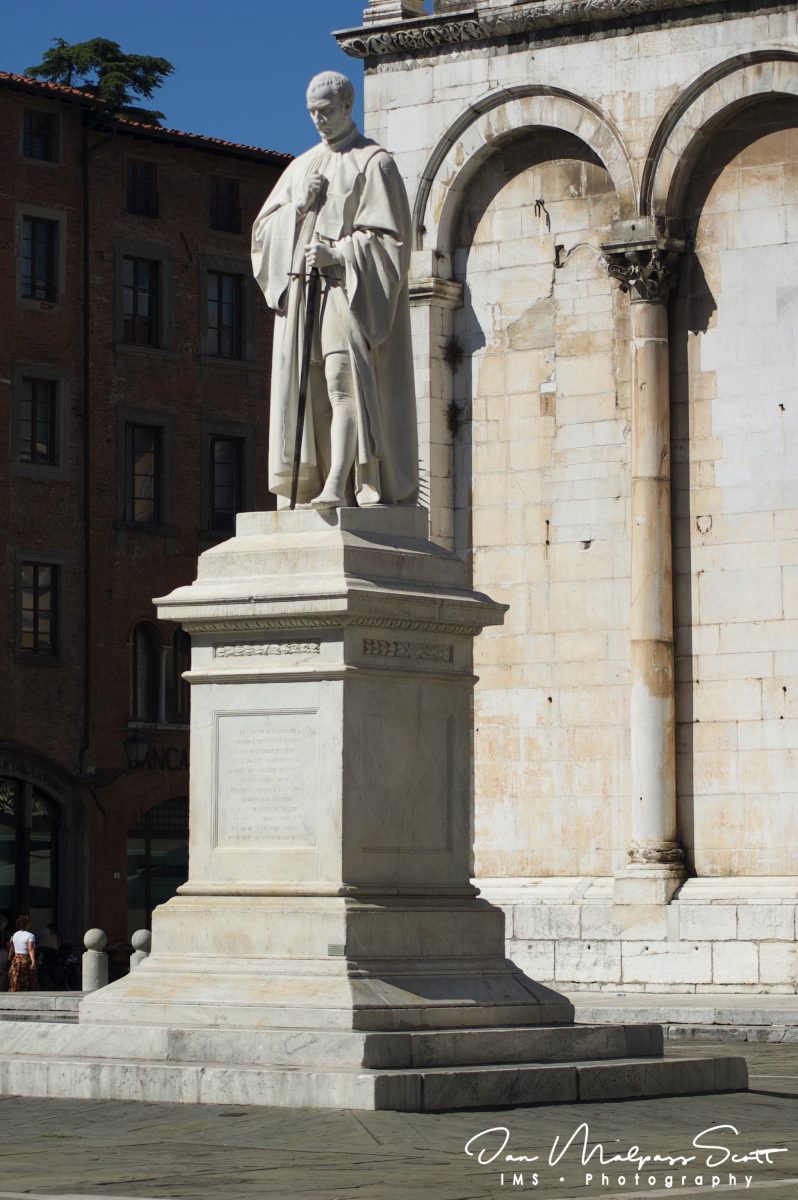Statue of Francesco Burlamacchi in Piazza San Michele.
Francesco Burlamacchi (Lucca, 27 September 1498 – Milan, 14 February 1547) was an Italian politician.
Belonging to the rich mercantile bourgeoisie of Lucca, he was elected gonfalonier of the Republic of Lucca in 1533.
Occupying the highest office of the state, he ordered a plan to break the hegemony of the Medici on Tuscany. The Lucchese troops should have attacked the Duchy of Tuscany in conjunction with anti-media rebellions that should have exploded in Florence and Pisa. Other rebellions would have been exploded simultaneously in various cities of Romagna, while the Burlamacchi also counted on the accession of the Republic of Siena to the war against the Medicean State.
The project was unveiled by a traitor to Duke Cosimo. At that point a serious accident broke out between the Tuscan State and the Republic of Lucca. Cosimo, considering that the head of the Lucca State had hatched a real war against him, he demanded delivery. The Republic of Lucca, however, could not give in to such a claim without becoming in fact a protectorate of the Medici. The war therefore seemed inevitable.
The emperor Charles V, however, given that the survival of the Lucchese State was a welcome thing for him, he wanted to intervene in the dispute before passing from the diplomacy to arms. Lucca was the only Italian imperial city and the empire did not intend it to be annexed to Tuscany. The Emperor then asked that the Burlamacchi be delivered to him. Lucca, which could not have given its own citizen in the hands of any foreign state, had to adapt and gave it to the hands of the imperial authority from which, since 1369, the very existence of the Lucca State was guaranteed.
The Burlamacchi was thus judged by an imperial court in Milan and beheaded at dawn on February 14, accused of having troubled peace among the Italian states.
The vision of the Burlamacchi led to the birth, in central-northern Italy, of a confederation of republics (Lucca, Pisa, Siena, Florence and Romagna) of the Swiss type. Some suspect, even in the absence of documents in this regard, that the Burlamacchi had reformed ideas. The fact is that Michele Burlamacchi, the second son of the Lucca nobleman, emigrated, years later, to the Calvinist Geneva, becoming a leading figure among the rich Italian Protestants who lived there.
The figure of Francesco Burlamacchi was rediscovered by Italian federalists between 1847 and 1861. It was ill-suited to represent neo-Guelphism, but was nevertheless emblematic of the attempt to give life to a unitary state based on the union of Italian cities.
In 1859 the Provisional Government of Tuscany decided to erect a statue of the Burlamacchi in the central Piazza San Michele in Lucca. The act of the government of the baron Bettino Ricasoli aimed to win over the sympathy of the people of Lucca. Lucca had in fact been annexed to Tuscany in 1847 and the absolutist government of Leopold II had found strong opposition in the former Duchy of Lucca. This opposition was not only due to the loss of millennial independence, but also to some acts of the Tuscan government such as the downgrading of the University of Lucca. In essence, through the monument, the Tuscan government intended to communicate its diversity from the Grand Ducal regime and the recognition of the peculiar history of Lucca.
Today the statue and the figure of Burlamacchi have become a Masonic symbol (he is entitled a loggia of the city of Lucca – Grande Oriente d’Italia) and a reference for the people of Lucca who consider themselves anti-Tuscans. According to some, the statue was built with its back to the church just to indicate the strong contrasts between the figure of the Burlamacchi and the Catholic religion.


